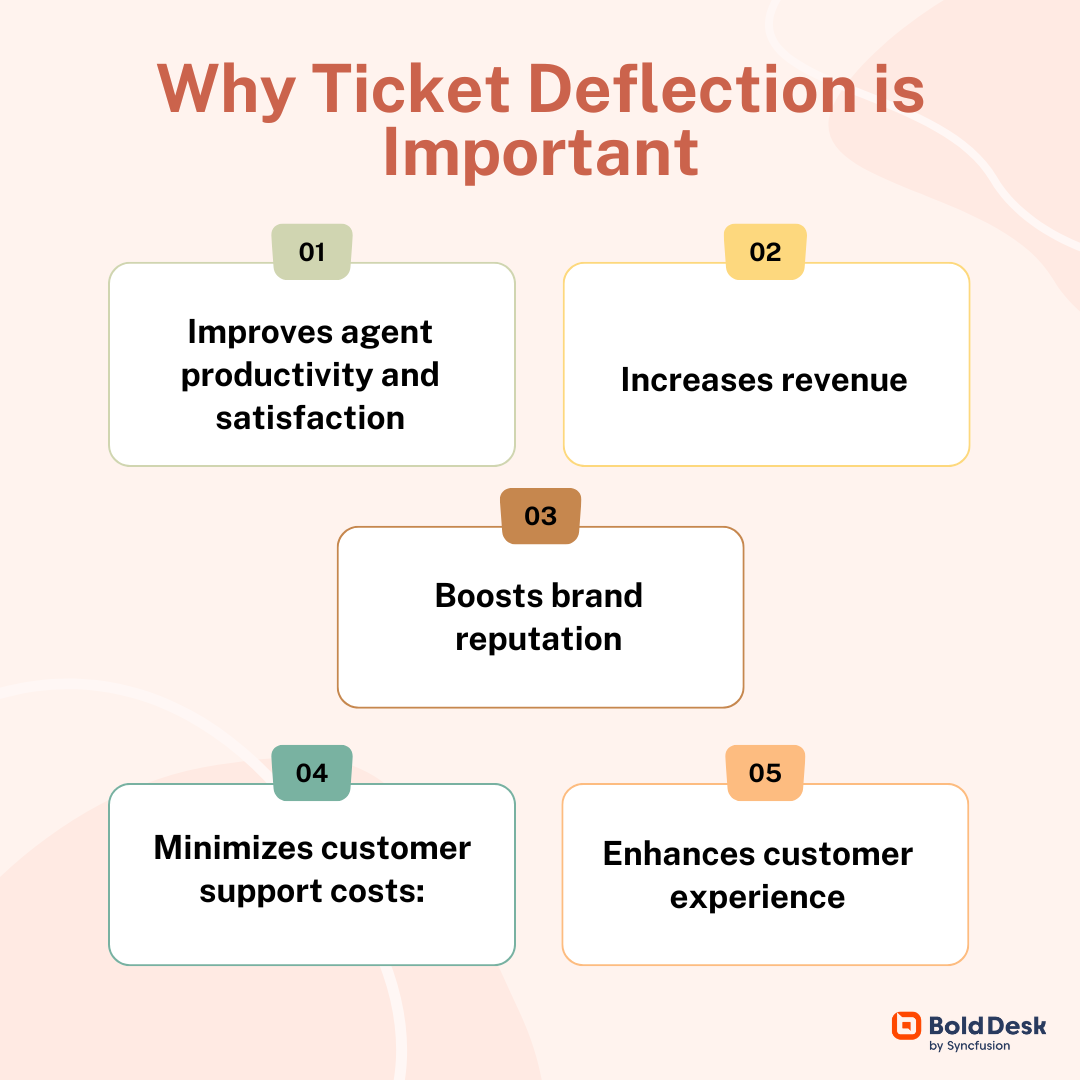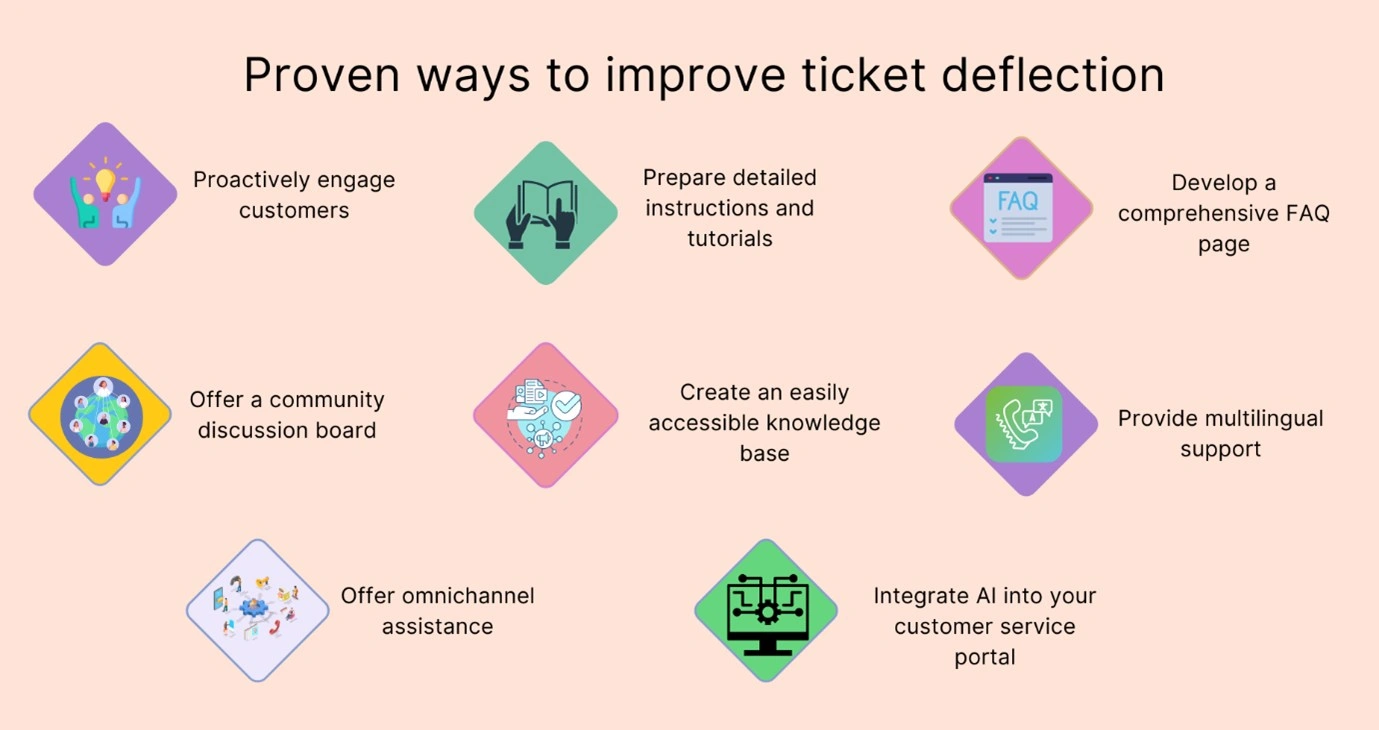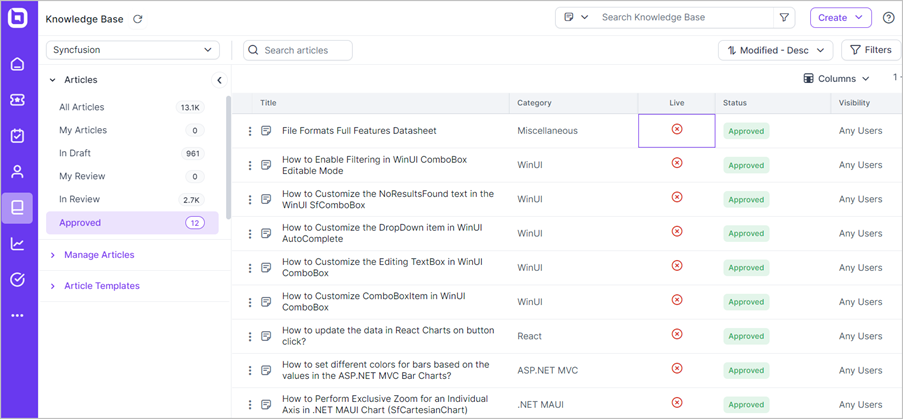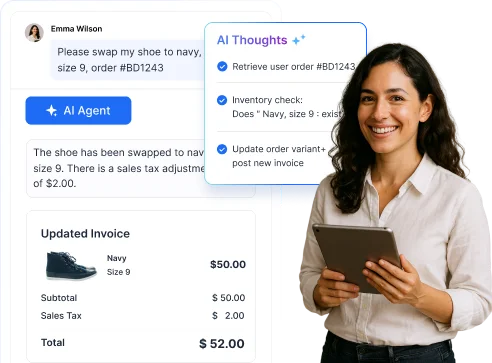When customers reach out for support, they often seek quick and straightforward answers. However, not every issue requires the involvement of an agent.
This is where ticket deflection comes into play. It focuses on providing support more intelligently rather than avoiding it.
Instead of overwhelming your support team with repetitive questions, ticket deflection empowers customers to find solutions through AI-powered assistance and self-service tools such as knowledge bases and FAQs.
By equipping customers with the resources they need at their fingertips, you can reduce routine inquiries and allow agents to concentrate on more complex or high-priority tickets.
In this blog, we will explore the topic of ticket deflection, ways to monitor ticket deflection metrics, and how ticket deflection benefits companies of all sizes.
What is ticket deflection?
Ticket deflection is a customer support strategy designed to reduce the number of tickets submitted to your support team by helping customers find answers on their own.
It typically involves offering self-service options like knowledge bases, FAQs, community forums, or AI-powered live chat. When implemented well, ticket deflection not only reduces support volume and costs but also empowers customers and improves satisfaction.
According to a survey by Higher Logic, 84% of customers try to solve their issues independently before contacting support, and 79% expect businesses to provide self-service tools that allow them to do so.
These expectations make it increasingly important for companies to embrace ticket deflection, not just as a cost-saving measure but as a core part of a modern, customer-friendly support experience.
How ticket deflection works
Ticket deflection aims to resolve customer queries before they become formal support tickets by guiding customers to self-service solutions.
It begins when a customer initiates a query, at which point the system presents self-service options like a knowledge base search bar, chatbot, or in-app help.
If the customer finds a solution through these tools, the query is deflected, and no new ticket is created.
This process is effective because it offers immediate answers, caters to customer preference for self-service, and frees up human agents for more complex issues.
Benefits of ticket deflection
Ticket deflection is crucial to customer support teams because it has several positive effects on their daily performance. These are a few of its major advantages:

- Improves agent productivity and satisfaction: By diverting simple questions away from support agents, agents can spend more time solving difficult issues rather than performing repetitive tasks. This helps them be more efficient and satisfied in their job.
- Increases revenue: Happy customers are loyal customers. When their problems are quickly and easily solved using self-service options, they are more likely to remain a customer and might even spend more.
- Boosts brand reputation: Providing excellent self-service experiences strengthens perceptions of the brand, potentially attracting new customers.
- Minimizes customer support costs: Fewer tickets mean less time spent by agents resolving them. This translates to lower overall costs for running your support team.
- Enhances customer experience: Customers can find answers quickly and conveniently without waiting for an agent. This empowers them to take control.
Key components of ticket deflection
Now that we know how important ticket deflection is, we need to understand what goes into the process. To effectively deflect tickets, brands need to consider the following key components:
Knowledge bases
A comprehensive knowledge base can be a great tool for ticket deflection. It allows customers to solve their issues independently by looking through the articles, self-help guides and videos.
This eliminates the need to wait long hours for a response from a support agent as clients can get answers immediately, on their own.
Frequently asked questions (FAQs)
FAQs provide quick and accessible answers to common questions that customers may have. Since most support requests may be for frequent issues, FAQs are an effective tool in ticket deflection.
Community forums
Online message boards and forums foster knowledge sharing and peer-to-peer support. Clients can find answers to common questions from previous posts, eliminating the need to contact support.
Moreover, clients can ask more experienced users questions regarding a product or service and get the response they require.
Chatbots
Chatbots are computer software programs that use AI to come up with human-like responses to customers’ queries. Whenever a customer seeks assistance and there is no support agent present, a chatbot provides a response instantly, keeping the client engaged.
Chatbots can also direct clients to specific knowledge base articles and escalate complex issues to human agents.
Metrics for ticket deflection and self-service support
You should evaluate targeted support metrics before and after adopting any ticket deflection techniques to understand your plan’s effectiveness.
Here are several metrics that are vital for accurate assessment:
Ticket deflection rate
The ticket deflection rate is the percentage of support tickets that are solved using self-service support options.
The formula for finding ticket deflection rate is:

A higher ratio indicates better ticket deflection, meaning more customers found solutions to their problems independently.
Self-service engagement rates
Measure how long, how often, and how many users interact with self-service content. Common measurements include time spent on articles, video views, unique users, link clicks, and upvotes.
Use these metrics to:
- Gauge whether customers find your self-service content useful.
- Identify common customer pain points.
- Know the areas for improvement in your content, your product, and your support.
Tip: Utilize reporting and analytics to collect these metrics in real time and make informed decisions on the fly to enhance customer service.
Effective ways to reduce support tickets
There is no universal approach to ticket reduction. To effectively reduce incoming customer requests, especially those that concern frequently asked questions, consider these tactics to find the best approach for your business.

Proactively engage customers
Don’t wait for customers to contact you for support. Deliver proactive customer service by initiating conversations, assisting with product choices, and providing knowledge base articles.
Include answers to familiar questions on product pages to enable customers to check FAQs before they need to open a ticket. This helps customers resolve issues without contacting an agent, increasing ticket deflection.
Prepare detailed instructions and tutorials
Create interactive resources that can help customers resolve their issues independently, such as troubleshooting guides and how-to videos.
By ensuring that these resources are accessible 24/7, your customers can help themselves beyond regular business hours. This helps to reduce support tickets being generated.
Develop a comprehensive FAQ page
Develop answers to the most frequently asked questions and common issues that customers face. You can then store them in a central, customer-facing location.
Periodically review and update them to incorporate the latest support trends and customer feedback. This improves ticket deflection and lets customers find solutions to their queries on their own.
Offer a community discussion board
Create an online community forum to help customers engage with one another. It also helps them address any issues with your brand, and share their experiences.
A forum assists customers in troubleshooting matters. Additionally, community forums can serve as useful avenues for:
- Gathering product ideas.
- Identifying bugs.
- Collecting customer feedback.
Create an easily accessible knowledge base
A self-service knowledge base enables customers to find the information they need independently instead of waiting for assistance.
Keep your knowledge base articles up to date with the most current information and solutions.
Optimize articles for search by including common keywords and phrases that customers will likely use.

Provide multilingual support
Utilize a multilingual knowledge base to reach a worldwide customer base and efficiently address customer demands.
Developing a multilingual self-service portal will simplify your clients’ search for answers and act as a ticket deflector tool for your support team.
Offer omnichannel assistance
Ensure that your self-service support is accessible across all customer interaction points.
This includes offering omnichannel support that allow support agents to handle customer issues from various communication channels such as, email, mobile apps, and social media within a unified platform.
Coordinating your self-service tools with these customer communication channels is essential to increasing ticket deflection. It ensures delivery of a seamless self-service support experience across all touchpoints.
Integrate AI into your customer service portal
Incorporate AI into your customer self-service portal to deflect tickets. To do this, you can:
- Offer answers 24/7 through smart live chat.
- Suggest relevant resources through AI-powered prediction tools.
Using AI frees up your support team, empowers customers, and saves everyone time.
Common ticket deflection implementation challenges and solutions
Implementing effective ticket deflection strategies can transform customer support operations, but the journey is rarely smooth.
Here are common ticket deflection implementation challenges along with practical solutions to help support teams overcome them and improve efficiency:
Low visibility of self-service resources
Customers often bypass self-service tools because they aren’t prominently displayed or accessible.
Solution:
- Feature your knowledge base, FAQs, and chat widget clearly on your homepage, product pages, and contact page.
- Include self-service options in email signatures and automated responses.
- Train agents to actively promote self-service channels for common queries during live interactions.
Poor quality or outdated content
If knowledge base articles are hard to understand, outdated, or incomplete, users won’t trust or rely on them.
Solution:
- Regularly audit and update content based on ticket trends and customer feedback.
- Involve support agents in identifying knowledge gaps and encourage ongoing content improvements.
Ineffective search functionality
Users can’t find answers if the search engine doesn’t return relevant or accurate results.
Solution:
- Use AI-powered or keyword-optimized search tools.
- Ensure all articles are tagged properly, structured clearly with headers and keywords, and written in plain language.
Limited feedback and tracking
Without proper tracking, it’s difficult to know if deflection strategies are working or which areas need improvement.
Solution:
- Use analytics to monitor deflection rates, article engagement, search queries with no results, and user feedback. Use this data to continuously refine your self-service strategy.
Ready to effectively deflect support tickets? BoldDesk® has you covered
BoldDesk supports ticket deflection through a combination of intuitive self-service tools and intelligent automation.
Its built-in knowledge base allows support teams to create, organize, and maintain help articles, FAQs, and guides that empower customers to resolve issues on their own.
As users begin typing their queries into the support form, BoldDesk automatically suggests relevant articles in real time, often resolving the issue before a ticket is submitted.
Additionally, the platform offers in-app help widgets that can be embedded directly into websites or products, providing contextual assistance and directing users to helpful resources without needing to contact support.
BoldDesk also features a powerful AI-driven search that ensures users find the most relevant content quickly and easily.
Together, these features reduce ticket volume, increase efficiency, and enhance the overall customer experience.
Enhance your ticket deflection strategy for improved efficiency
Implement self-service options and ticket deflection techniques to help your support agents become more efficient with their time and give your customers a level of control in resolving their issues.
If you have any questions about BoldDesk and its capabilities, contact the support team.
Do you have any suggestions for reducing support ticket inflow that you would like us to add to this article? Please leave your recommendations in the comments section below.
Related articles
- 20+ Top Knowledge Base Examples to Boost Self-Service Support
- Role of Self-Service in Modern Helpdesk Solutions
- Customer Self-Service: What It Is and How to Succeed It Right



















 Email Ticketing System
Email Ticketing System Shared Inbox Software
Shared Inbox Software Multi Brand Help Desk
Multi Brand Help Desk Internal Help Desk Software
Internal Help Desk Software Trouble Ticketing Software
Trouble Ticketing Software Mobile Help Desk
Mobile Help Desk 
















